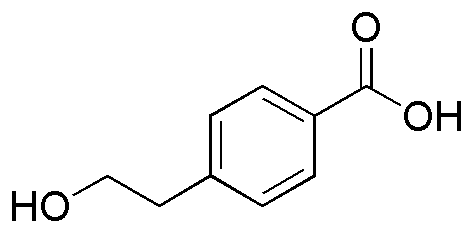4-(2-Hydroxyethyl)benzoic acid is widely utilized in research focused on:
- Pharmaceutical Formulations: This compound acts as a pH stabilizer and solubilizing agent in drug formulations, enhancing the bioavailability of active ingredients.
- Cosmetic Products: It is commonly used in skincare formulations for its moisturizing properties, helping to improve skin hydration and texture.
- Polymer Chemistry: This compound serves as a building block in the synthesis of polyesters, which are used in a variety of applications, including biodegradable plastics.
- Food Industry: It can be utilized as a food additive, providing preservative qualities and improving the stability of food products.
- Research Applications: In laboratory settings, it is used as a reagent for synthesizing other chemical compounds, facilitating various organic chemistry experiments.
General Information
Properties
Safety and Regulations
Applications
4-(2-Hydroxyethyl)benzoic acid is widely utilized in research focused on:
- Pharmaceutical Formulations: This compound acts as a pH stabilizer and solubilizing agent in drug formulations, enhancing the bioavailability of active ingredients.
- Cosmetic Products: It is commonly used in skincare formulations for its moisturizing properties, helping to improve skin hydration and texture.
- Polymer Chemistry: This compound serves as a building block in the synthesis of polyesters, which are used in a variety of applications, including biodegradable plastics.
- Food Industry: It can be utilized as a food additive, providing preservative qualities and improving the stability of food products.
- Research Applications: In laboratory settings, it is used as a reagent for synthesizing other chemical compounds, facilitating various organic chemistry experiments.
Documents
Safety Data Sheets (SDS)
The SDS provides comprehensive safety information on handling, storage, and disposal of the product.
Product Specification (PS)
The PS provides a comprehensive breakdown of the product’s properties, including chemical composition, physical state, purity, and storage requirements. It also details acceptable quality ranges and the product's intended applications.
Certificates of Analysis (COA)
Search for Certificates of Analysis (COA) by entering the products Lot Number. Lot and Batch Numbers can be found on a product’s label following the words ‘Lot’ or ‘Batch’.
*Catalog Number
*Lot Number
Certificates Of Origin (COO)
This COO confirms the country where the product was manufactured, and also details the materials and components used in it and whether it is derived from natural, synthetic, or other specific sources. This certificate may be required for customs, trade, and regulatory compliance.
*Catalog Number
*Lot Number
Safety Data Sheets (SDS)
The SDS provides comprehensive safety information on handling, storage, and disposal of the product.
DownloadProduct Specification (PS)
The PS provides a comprehensive breakdown of the product’s properties, including chemical composition, physical state, purity, and storage requirements. It also details acceptable quality ranges and the product's intended applications.
DownloadCertificates of Analysis (COA)
Search for Certificates of Analysis (COA) by entering the products Lot Number. Lot and Batch Numbers can be found on a product’s label following the words ‘Lot’ or ‘Batch’.
*Catalog Number
*Lot Number
Certificates Of Origin (COO)
This COO confirms the country where the product was manufactured, and also details the materials and components used in it and whether it is derived from natural, synthetic, or other specific sources. This certificate may be required for customs, trade, and regulatory compliance.


